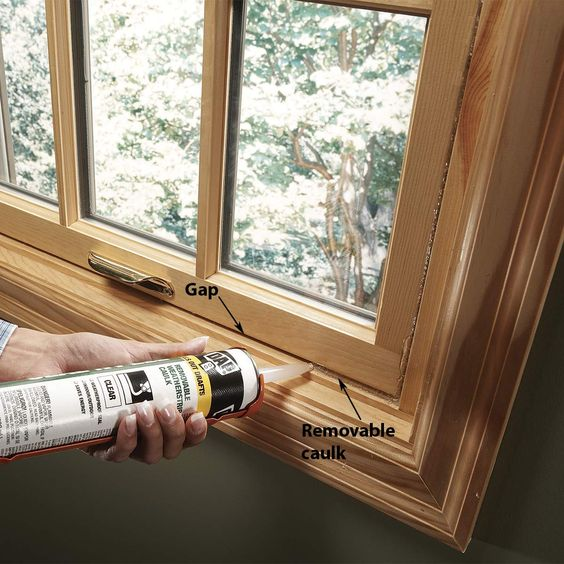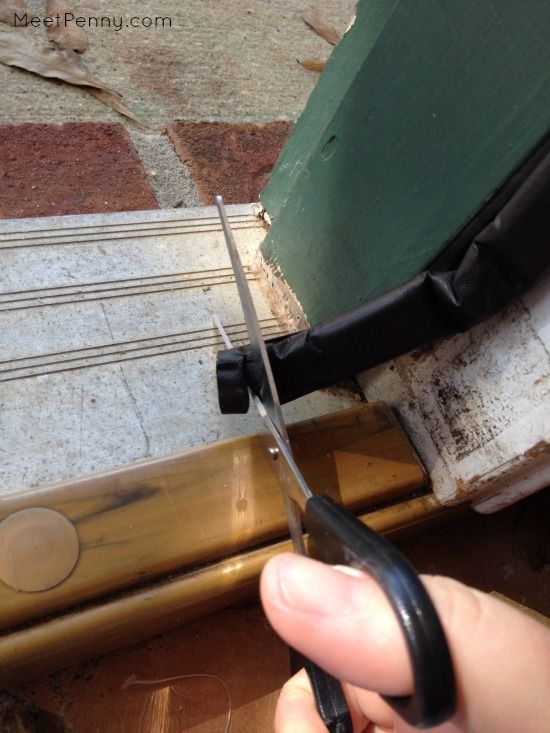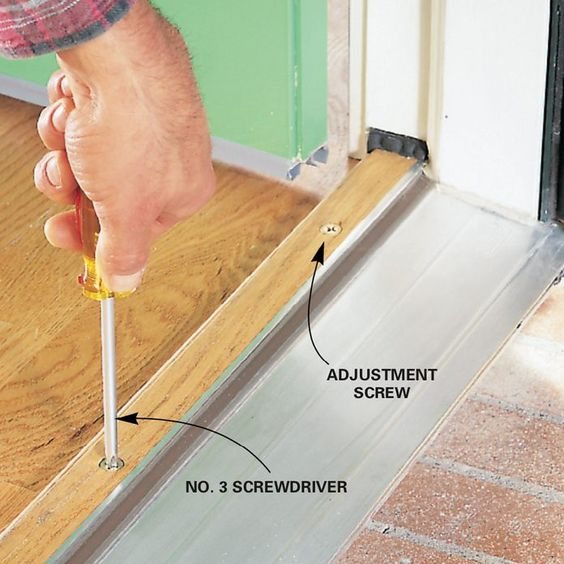When it rains, you must know how to stop water from coming under door and keep your home safe and dry. Nothing is more frustrating than dealing with a leaky door that lets in water every time it rains.
One rainstorm, I came home to find water pouring into my house through the door. After some quick investigation, I realized that the door had been leaking and letting in a torrent of water. Luckily, I could stop the leak quickly and prevent any further damage from occurring.
How To Stop Water From Coming From The Bottom of The Door
First, check the door sweep and ensure it is securely in place. Second, make sure that the threshold is level and in good condition. And finally, weatherstripping will need to be applied if the gap between the bottom of the door and the floor is more than 1/4 inch.
Related: Water Leaking From Furnace? Here’s What To Do
Tips on Preventing Water Leaks and What to Do if It Happens.
Water entering your home through the bottom of the door can be a common problem, and there are several reasons why it may occur. Some possible reasons include the following:
- Leaking or improperly sealed doors
- Damaged door thresholds or weather stripping
- Malfunctioning door sweeps or other types of water barriers
The things you will need are:
- Dish soap
- Putty knife
- Utility knife
- Caulking gun
- Outdoor caulk
- Rubber mallet
- Screwdriver
- Bottom weatherstrip or door sweep
If you notice water coming in under the door, it’s important to take action immediately. Some steps you can take to address the issue include:
- Checking the seal around your doors, ensuring that it is tight and free of cracks or gaps.
- Re-sealing any damaged door thresholds or weather stripping as needed.
- Ensuring that your door sweeps and other water barriers are functioning properly and not clogged with debris.

Additionally, taking steps to prevent water from entering your home can help minimize the risk of water damage and other issues caused by excess moisture. Some measures you can take include:
- Adequate caulking around windows and doors to prevent leaks
- Adding gutter extensions or diverters to direct water away from your home
- Installing exterior drainage systems and dry wells to collect and divert excess water
- Using heavy-duty mats at doorways or adding a layer of gravel along the bottom of doors to help catch water before it enters the house.
The Benefits of Door Thresholds
Door thresholds have many benefits that make them an important part of your home’s structure and design. Some of their main functions include:
- insulating your home against outside temperatures
- reducing drafts
- preventing bugs from entering your home
- creating a transition between different floor levels.

The Instructions for Making the Door Water-Proof
Looking to make your door more water-resistant and keep water from seeping in under the bottom? Here are a few steps to help you.
1. Check the Condition of Your Door Sweep and Threshold.
Ensure that these components are in good shape, free of cracks or gaps, and properly sealed. If either of these components is damaged or worn, consider replacing them as needed.
Many door thresholds are available, including metal, wood, vinyl, and rubber. The type you choose will depend on your personal preferences and the specific needs of your home.
You will need these materials to anchor your door threshold:
- A broom
- Dish soap and water
- A cordless drill or cordless screw gun
- Drill bits
- Leak Stopper Clear Patch
- A caulk gun
- Screws
- Paper towels
- Leak Stopper Rubber
Usually, Caulking involves applying a leak stopper clear patch between the threshold and the thing below it.
Use a cordless screw-gun, to easily screw through the threshold and ground or door sill. Then, with paper towels clean the excess caulk and apply the final seal.
2. Apply Weatherstripping to Help Create a Tighter Seal.
If the gap between your door and floor is over 1/4 inch, you may need to apply weatherstripping. You can purchase pre-made weatherstripping strips from your local hardware store or create your own using liquid rubber, foam, felt, or other durable material.
3. Consider Consulting With a Professional.
If water continues to seep in despite following the steps above, consider consulting with a professional about installing a new door threshold and weatherstripping components. This may involve replacing the existing threshold with a higher-quality model, adding additional sealant or weatherstripping, or using a different type of barrier material.
4. Take Preventative Measures to Keep Water From Entering Your Home
In addition to taking steps to seal your door, it can also be helpful to take preventative measures to keep water from entering your home in the first place. For example, you can also do adequate caulking around windows and doors, installing gutter extensions or diverters to channel water away from your home, and adding exterior drainage systems and drywells to help collect excess water.
How to Add Weatherproofing Sweeps
Begin by removing the existing door sweep or threshold, using a screwdriver to loosen any screws that may be holding it in place.
The two types of door sweeps are u-shaped or metal strip that can be screwed/nailed at the bottom.
Next, measure the width of your door opening and purchase a new weatherproofing sweep slightly wider than this measurement.
Once you have your new sweep, use a level to ensure that it is properly aligned, and then secure it in place using the screws that came with the product.
Finally, test your door’s seal to ensure it is fully water-tight and adjust any components as needed.

Causes Of Water Leaks On Aluminum or Metal Doors
Several common causes of water leakage on aluminum or metal doors include damage to the door sweep or threshold, poor weatherstripping, and improper installation. These issues can be caused by several factors, such as improper sealing against moisture and air infiltration, warped or damaged door frames, and loose fasteners.
If you are experiencing water leakage on your aluminum or metal doors, it is important to identify and address the underlying cause as soon as possible.
Related: Sump Pump Maintenance (To Prevent Water in Your Basement)
Causes Of Water Leaks On A Exterior Door Frame
One of the most common causes of water leaks on a door frame is improper installation. If the door frame is not installed level with the surrounding wall, then there will be gaps where water can seep through.
In addition, if the door frame is not installed square with the wall, then there will be larger gaps that allow more water to pass through. Proper installation is essential in preventing water leakage.
Another common cause of water leaks is damaged or missing sealant. Sealant helps fill in gaps between the door frame and the wall, creating a barrier that prevents water from passing through.
Over time, sealant can become cracked or worn away, leaving gaps that allow water to seep through. Inspecting and repairing sealant regularly can help to prevent water leakage.
If there is not enough ventilation around the door frame, improving ventilation can help preventing water leakage and condensation.
Water Leaks On A Garage Door Frame
Garage door frame repair is not always as simple as it sounds. In some cases, the damage to the door frame may be too significant to repair.
In other cases, the damage may be minor and easily fixed. However, the cause of water leaks on a garage door frame is usually due to improper installation or maintenance.
Regularly check for any damage or wear and tear to prevent water leaks on a garage door frame. In addition, you should periodically check the weather stripping and sealant condition to ensure they are still in good condition.
Expert Tips and Trends in 2022
There are some door-stopping water expert tips and trends to be aware of in 2022. One door-stopping water trend is the increasing use of door stops that prevent water from entering a home.
This is especially important in areas prone to flooding or where hurricanes are common (1). Door stops that prevent water can be placed inside or outside of doors and can be made of various materials, including plastic, metal, or rubber.
Another door-stopping water trend is the use of door gaskets. Gaskets are seals placed around door frames to prevent water from entering a home. Door gaskets are available in various sizes and thicknesses to fit any door.
Finally, another door-stopping water trend is the use of door sweeps. Door sweeps are strips of material that are placed at the bottom of doors to seal gaps and prevent water from entering a home.
How to save Carved Wooden Door from water leaks damage
Water leaks can cause extensive damage to carved wooden doors, particularly if left unrepaired for a prolonged period. Luckily, a few simple steps can be taken to minimize the risk of water damage.
First, it is important to regularly check the door for any signs of water infiltration, such as warping or discoloration (2). If any leaks are discovered, they should be promptly repaired.
Second, the door should be protected from the elements by applying a layer of waterproof sealant. This will help to create a barrier against moisture, ensuring that the door stays in good condition for years to come.
Finally, it is essential to take action immediately if water does leak into the door, as this can rapidly lead to further damage.
These simple precautions can help keep your carved wooden door looking its best for many years.
Related: Wood Floor Water Damage: What You Need To Know and Do
How to stop water from coming under door FAQ
How do I stop water from coming from the bottom of my door?
There are a few things that you can do to stop water from coming in from the bottom of your door. One is to ensure that the door seal is in good condition and there are no gaps or cracks.
Another is to install a door sweep at the bottom of the door. This will help to create a barrier against water, wind, and dirt.
Finally, you can also try using weatherstripping around the door’s perimeter to create an additional layer of protection.
Taking these steps can help prevent water from entering your home through the bottom of the door.
Why is water coming in under the door?
There are several reasons why water is coming from the bottom of the door. For example, lack of adequate caulking around the door, cracked or deteriorated weather stripping, and improper installation of weather stripping under the door.
For instance, weatherstripping or installing a threshold if your door is drafty can help seal off the opening and keep water out. If you live in an area with a lot of rainfall, then you may need to install a drainage system around your home to redirect water away from your door.
Conclusion
Water coming in from under a door can potentially damage your home. If you are experiencing water coming in under your door, there are several steps that you can take to stop it and protect your home.
These may include installing a door sweep or weatherstripping, improving the seal around your door, or using other protective measures like a drainage system.
To address more severe issues with water leakage, consult a professional or seek more advanced solutions like replacing damaged door components or installing new door seals.
Sources
(1) – https://oceanservice.noaa.gov/facts/hurricane.html
(2) – https://www.sciencedirect.com/topics/materials-science/discoloration
The post How to Stop Water From Coming Under Door appeared first on Millennial Homeowner.